Might the antidote to some future/present sense of powerless miasma to an algorithmic fueled inescapable AI matrix be just human created quirkiness?
Join me (or click away quickly now) for another rummaging in an old hard drive of 1990s website files for a taste of the uncharted freedom when we created digital content without platforms and constraining systems of convenience.
Not remembering which stream of information led me to maybe the most meaningful framing of the web of dreams from my entre in 1993 to the nested tangle of surveillance capitalism track me with your cookie web of 2021.
This framing comes from an essay by Olia Lialina as From My to Me, opening with
Me is cheap, Me is easy to control, Me is easy to channel, Me is slave of its own reflection, Me is a slave of the platforms that make the reflection glossy. Me is data. Me is data closest to metadata. This makes Me just perfect to satisfy advertisers and to sate neural networks.
I first encountered Olia’s work in the 2006 retrospective New Media Art on net art. This is a semifloundering project to revisit entries to find if they still are viewable now (I sometimes had students take on pieces as research projects). See the entry for My Boyfriend Came Back From the War, a gripping GIF based narrative that holds up well 25 years later. Not surprisingly as someone who cares for keeping the web a living organism, Olia’s is one of the few examples from this book still available on the web.
Oops, that was an aside. Back to from My to Me.
Olia’s perspective is deeply rooted in a heroic effort to archive, analyze the portion of the web’s history that makes web professionals and pundits cringe, the 1995-2009 Geocities era that was unplugged by its owners.
One can easily look down one’s latest Grunt installed Zepto powdered nose at something like this

This is embarrassing as web design on so many levels, no? Who puts <br> tags in the header?
The Cricks did… because they could.
Don’t see making your own web page as a nostalgia, don’t participate in creating the netstalgia trend. What you make is a statement, an act of emancipation. You make it to continue a 25-year-old tradition of liberation.
Olia Lialina has published another essay on Interface Critique, called Rich User Experience, UX and the Desktopization of War.
To understand the history of the Web and the role of its users, it is important to acknowledge that people who built their homes, houses, cottages, places, realms, crypts, lairs, worlds, dimensions [Fig.1–13] were challenging the architecture and the protocols, protocols in a figurative not technical meaning. Users hijacked the first home page of the browser and developed this concept in another direction. A user building, moving in, taking control over a territory was never a plan. It was a subversive practice, even in 1995.
https://interfacecritique.net/book/olia-lialina-from-my-to-me
And it’s a forsaken practice in 2021.
With no surprise this all takes me back to making of “My” web sites in the early and mid-1990s. Before zipping down memory lane, overhead is a sign noting that this is in no way a nostalgic wish to return to this era (cue the sounds of dial-up modems). It’s more a check on what was done then and how means right here in 2021.
My memories of Geocities is a thin recollection of the idea of virtual neighborhoods. I never made anything there because starting in 1993 I got to run my own web server at the Maricopa Community Colleges. I had unfettered access to create what I wanted, largely as the web was not really on too many people in the system’s interest lists.
But here is the thing. The vast majority of my web work at the Maricopa Center for Learning & Instruction from 1993-2006 was built by hand (my work has been vaporized from the original source but I have been at work resurrecting what I can at a subdomain of my own http://mcli.cogdogblog.com).
At first this was all HTML, then some perl/cgi came into play, later PHP and some websites built with mySQL databases. A few wikis came into the mix, maybe some web bulletin board, and towards the latter, era my own blog (this one) on MovableType in 2003 and then WordPress in 2004.
I blogged though before using a platform. During a six month sabbatical in 2000, I built my own site (in my own domain) in raw HTML that was reverse chronologically organized with daily updates, photos, hand coded geolocation.
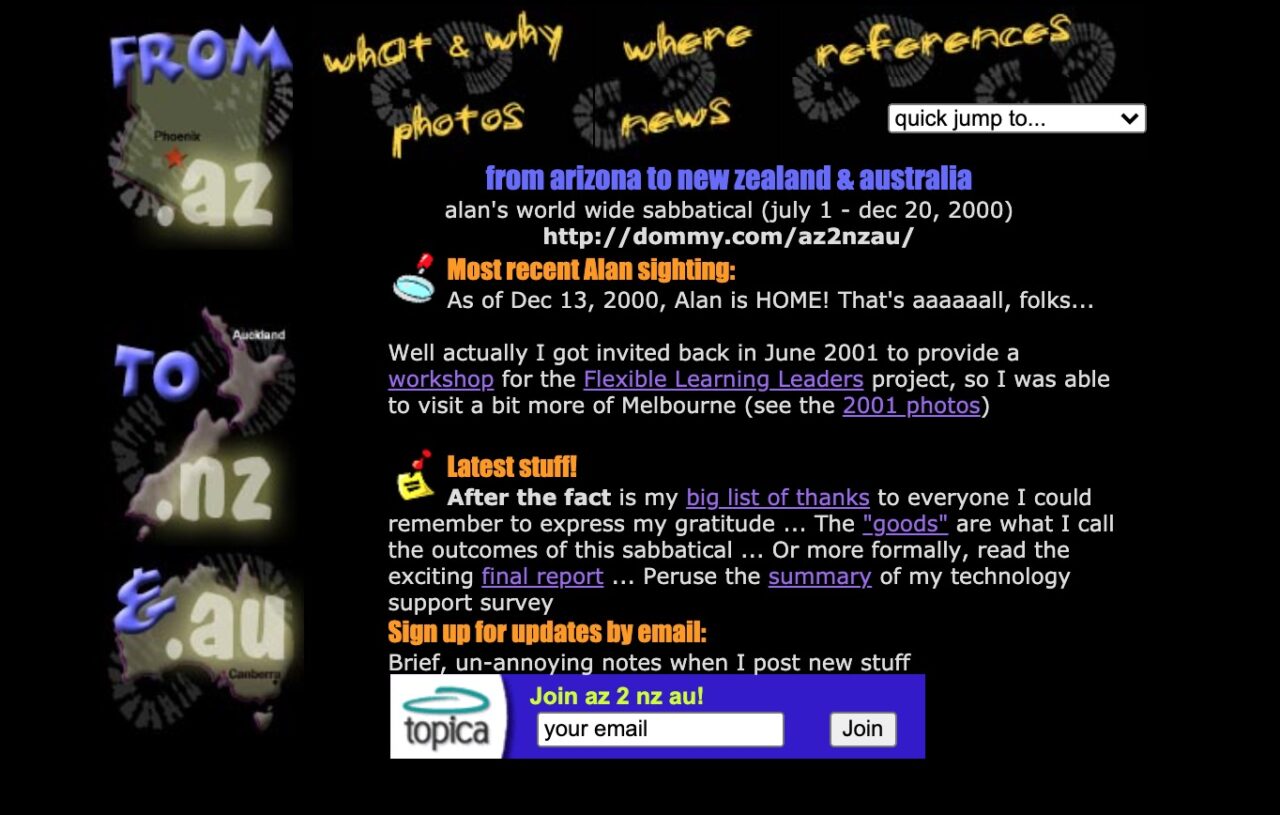
All of the project work at Maricopa was at its core, plain old HTML, using the same app I still use, Barebones software’s BB Edit. I made use of some macro-like capability, and later got to a point of making site that were a single PHP template for all headers, footers, menus, and content loaded from external files.
An archive of this work resides on a 40Gb hard drive so old it takes two dongles to connect the FireWire 400 port to a modern laptop.
The more I dig in there the more I see so much work I have forgotten. Quite likely much is forgettable. But all of it entered by my fingers and my lousy keyboard skills.
Picking up on Olia’s focus on “home pages” I dug around to find the ones I made for our center. I have a pretty full history of Web Servers I knew from 1993-2006– the earliest home page is a screenshot:
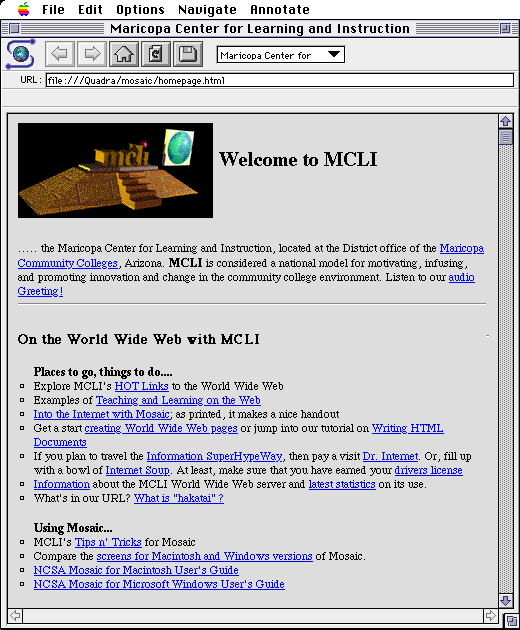
It’s as vintage cringe worthy of those Geocities page. That image as something rendered in Strata3D, software I was using then (or learning to use) for multimedia projects. Note the URL, this is my local building versions. Quadra was my desktop Mac Quadra 900, and the web server at the time so old that homepage.html was the default location.
It’s link heavy because the web was all about being interlinked. I can probably find most of the links. Then, as now, much activity was organizing resource links, or our “Hot” Links as well examples of the web used for teaching and learning. There’s a guide to building web content but more evolved as the Writing HTML tutorial (that’s a whole blog post coming sometime).
There was some poking at Al Gore’s pitching of the Information Superhighway but I guess he was not really off base. Ah, the internet soup, another rendered 3D graphic. This is I admit, 1990s graphic cheese wiz
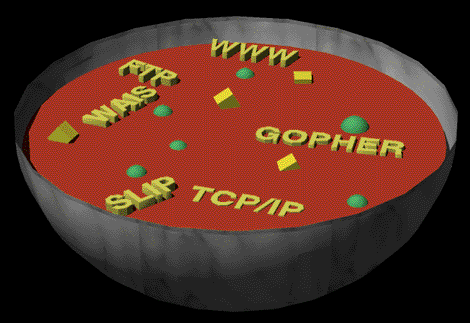
Not too much later, the MCLI Home Page was redone in stark white background and making use of our logo that was on our stationary and business cards. I must have had some prescience as I archived a copy of that page. It’s still link heavy. That welcome message (all 3 seconds) in .au audio format (it might still work) was the voice of our office manager Sandy.
Sometime during the end of 1994, I got a bit more experimental with an alternative “deluxe” home page (it was never the main one but likely linked). This one apparently influenced by the early NetScape mascot.
The archival sites I made removed all the links, but I do remember this one used HTML image maps to link parts of the graphic.
By the time of its first snapshot in the WayBack Machine (Dec 1998), the MCLI site was still a lot of links (more projects and sites), and a bit cleaner showing use of Ye Olde font tags and HTML table layouts.
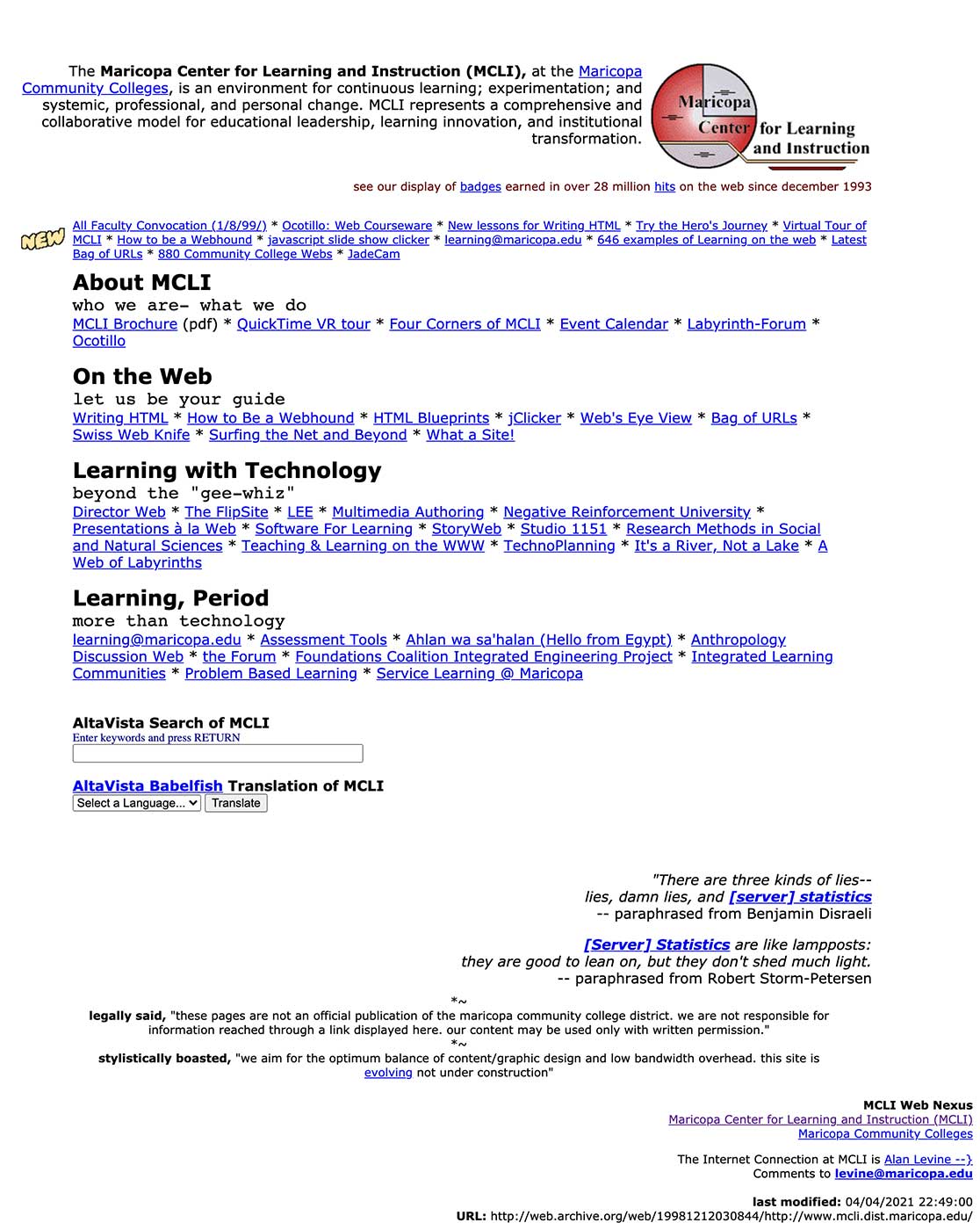
I am pretty much writing and making this what I want to do (see some of the tag lines and the snarky lines about statistics). You don’t see much of this in the brochure language of centers like this one today.
By 2001 there was a makeover to include “official” maricopa colors and logos. This was a PHP driven version, with some use of includes to list the numbers on the “dynamic” resources bottom left. It’s still table-based HTML with now some external CSS. And yes, links, links, links, all of these are other web sites, all done by hand.

The tour might be getting tedious, so here is the last stop, August 2003. The Vice Chancellor of Academic Affairs, which we reported to, put out a decree to all departments to collaborate to add a common header on all web sites. For most departments, this was a handful of web pages. For the web I had created there were thousands and thousands, but I recall arguing for using it on the major pages about our center. I may have helped them with a bit of Javascript for random photos in the top right.
I had my own PHP gizmo for pulling from a collection for the front “images of learning”. It may have been a text flat file database or maybe it was a MySQL thing.
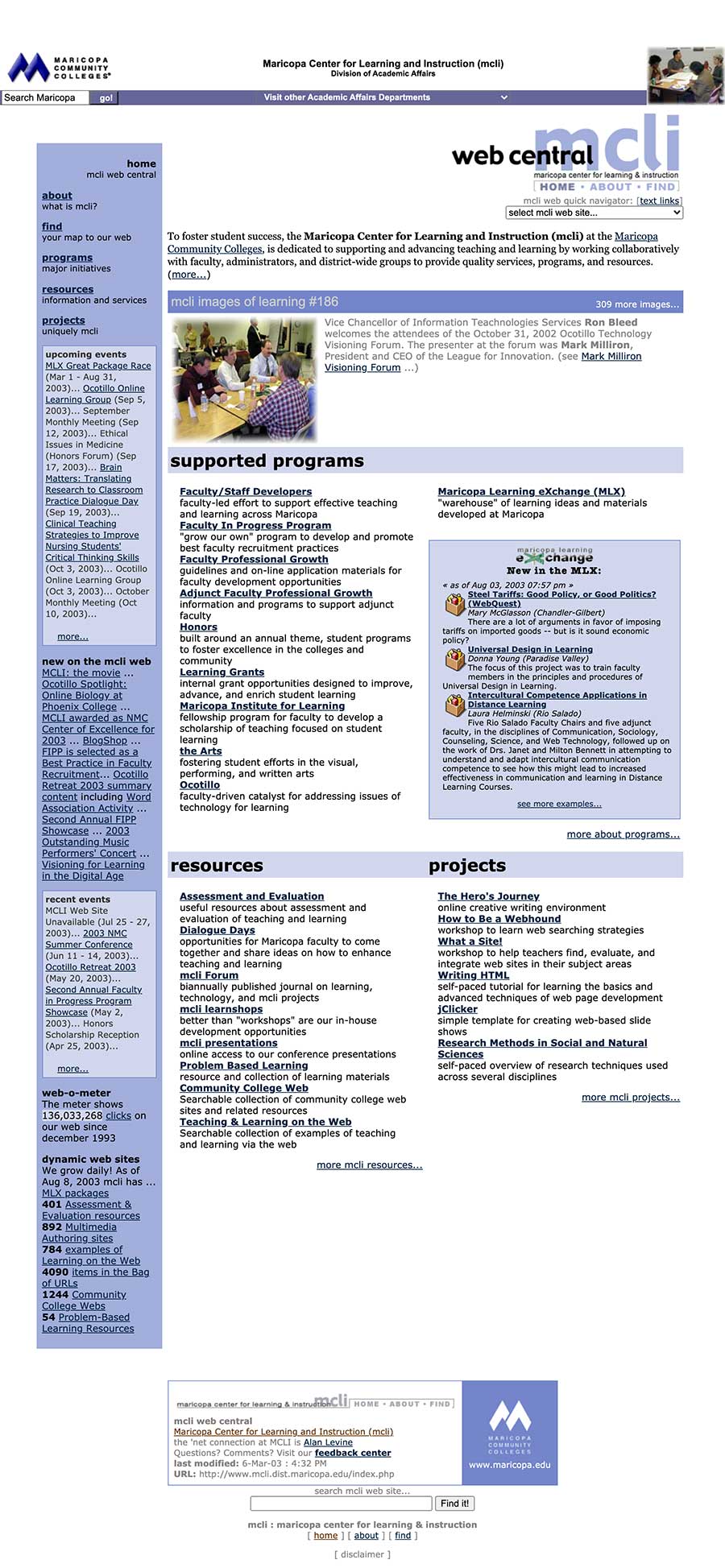
So What?
As often happens, the point I sought to make here might be lost with all my history digging and diversions. At the time I left my position at Maricopa (2006) I had crafted quite an untidy mess of connected by distinct web sites, even with reusing templates. Even with some under the hood scripting, these remained predominantly handmade sites, and while I would hope the designs do not make one think of Geocities, there’s more in common with those quirky web sites that the boilerplate sameness we see now.
This is what I see missing in the “Me” web Olia paints. With everything coming from platforms and all their buzzword juice, it’s often missing that element of signs of human craft.
I thought of the element I seek as “Web Handcraft” e.g. “skillfully made by hand” but it needs an extra “I” in there to be “Web Handicraft.”
A handicraft, sometimes more precisely expressed as artisanal handicraft or handmade, is any of a wide variety of types of work where useful and decorative objects are made completely by one’s hand or by using only simple, non-tech related tools like scissors, carving implements, or hooks.
https://en.wikipedia.org/wiki/Handicraft
Both “useful” and “decorative” are in play here but also “artisanal”.
I am not in any way suggesting everyone go hand built web content, and as much as I respect the IndieWeb movement, methinks that it’s too daunting for most.
But what I do yearn for and look in any platform, tool system, are the ways my knowledge of basic web standards can subvert, or end around the interfaces presented.
Knowing HTML and CSS get me probing around be it in the byzantine labythings of Moodle or EdX. But look at the comments of any WordPress blog. From what they give you, all you can enter is text. Unless you know how to hand write hypertext links, you are left to just words.
On entering some software or web platform, I am looking for the degrees of freedom it gives or takes from me.
- Can I get at the code itself? This is why self hosted WordPress is more handicraft than WordPress.com
- Is there access to a scripting environment?
- Can I extend functionality with plugins, extensions, or am I stuck with what a platform gives?
- In editing can I get to an HTML editor? Do I get all the tags or just a few? Do I get iframes?
- Can I override the CSS?
For all the things that are easy to do- send a tweet, post an image to instagram, you have very little degree of web handicraft freedom,
Olia’s message resonates with me, even if I still love me some WordPress. She suggests the platform drove people from linking, but I am not sure if that’s the platform as much as the more general drift to WYSIWIG dreams. With my self hosted WordPress, I find more degrees of creative freedom, but I do my own coding and tweaking.
She offers suggestions:
What can be done? How to reclaim My?
Don’t collaborate! Don’t post your texts where you are not allowed to turn it into hypertext.
Don’t post your pictures where you can’t link them to whatever you like. Don’t use content management systems that turn your GIFs into JPEGs. Don’t use hashtags, don’t accept algorithmic timelines. In short, make a web page and link to others who still have one.
https://interfacecritique.net/book/olia-lialina-from-my-to-me
“Don’t use content management systems that turn your GIFs into JPEGs.” that’s WordPress, but also not understanding the way WordPress makes these decisions. “Don’t post your texts where you are not allowed to turn it into hypertext.” that’s Instagram which confines you in beside “link in bio”
But she also suggests leaving or not using platforms is the right way either, it’s best (to me) to always see how you can subvert their limits. But the most key takeway is:
In short, make a web page and link to others who still have one.
Always be linking. Anywhere you can. And build your own stuff. Anyway you can. If you cannot make a hypertext link by hand, you are not free.
Handicraft over machinecraft.
That was my unhashtagged response:
Update: Wherefore art thou Web Handicraft?
By no means complete, these are places I sense the craft:
- CodePen – there are things I see here that drop the jaw to the ground with that expression of “how did they even figure that out? Look for or sign up for updates to CodePen Spark
- Glitch – It might look like candy colored GitHub and all the language of coding might deter, but the things you are able to create here go beyond just desktop HTML/CSS/Javascript, and what you can see publically can be copied and remixed. It picked up where Mozilla’s Thimble crumpled up and went away. Look for inspiration in the monthly recaps on the Glitch blog.
Got more? There’s a lonely comment box below.
Featured Image: pxhere image by muqitlahore shared into the public domain using Creative Commons CC0
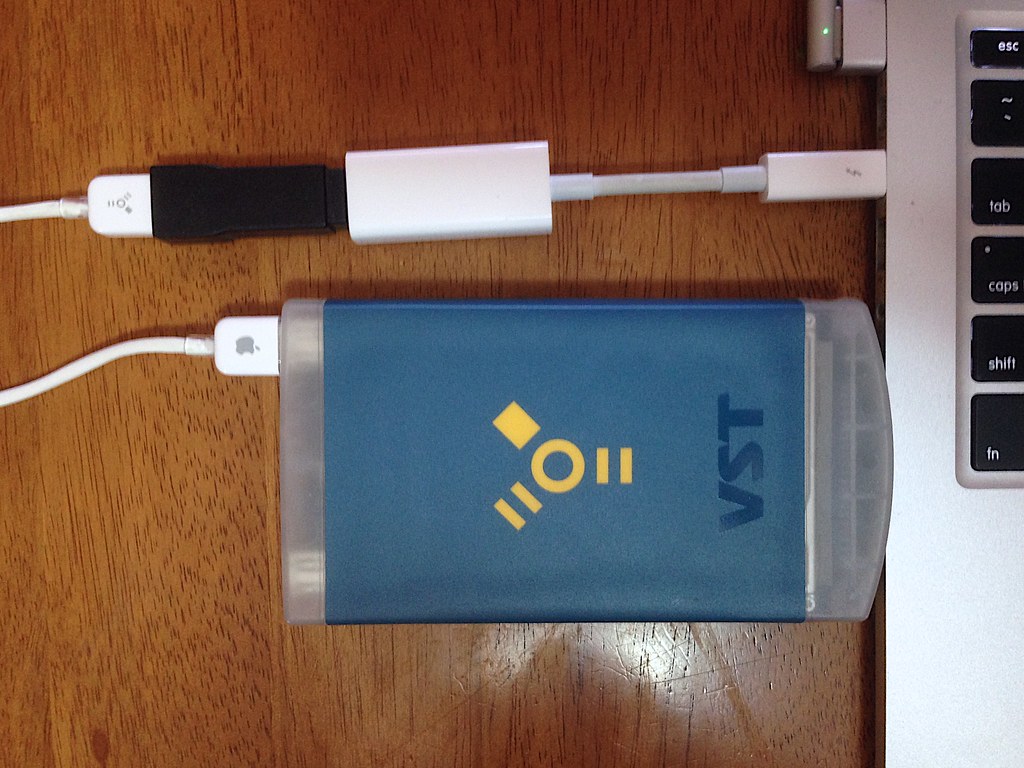

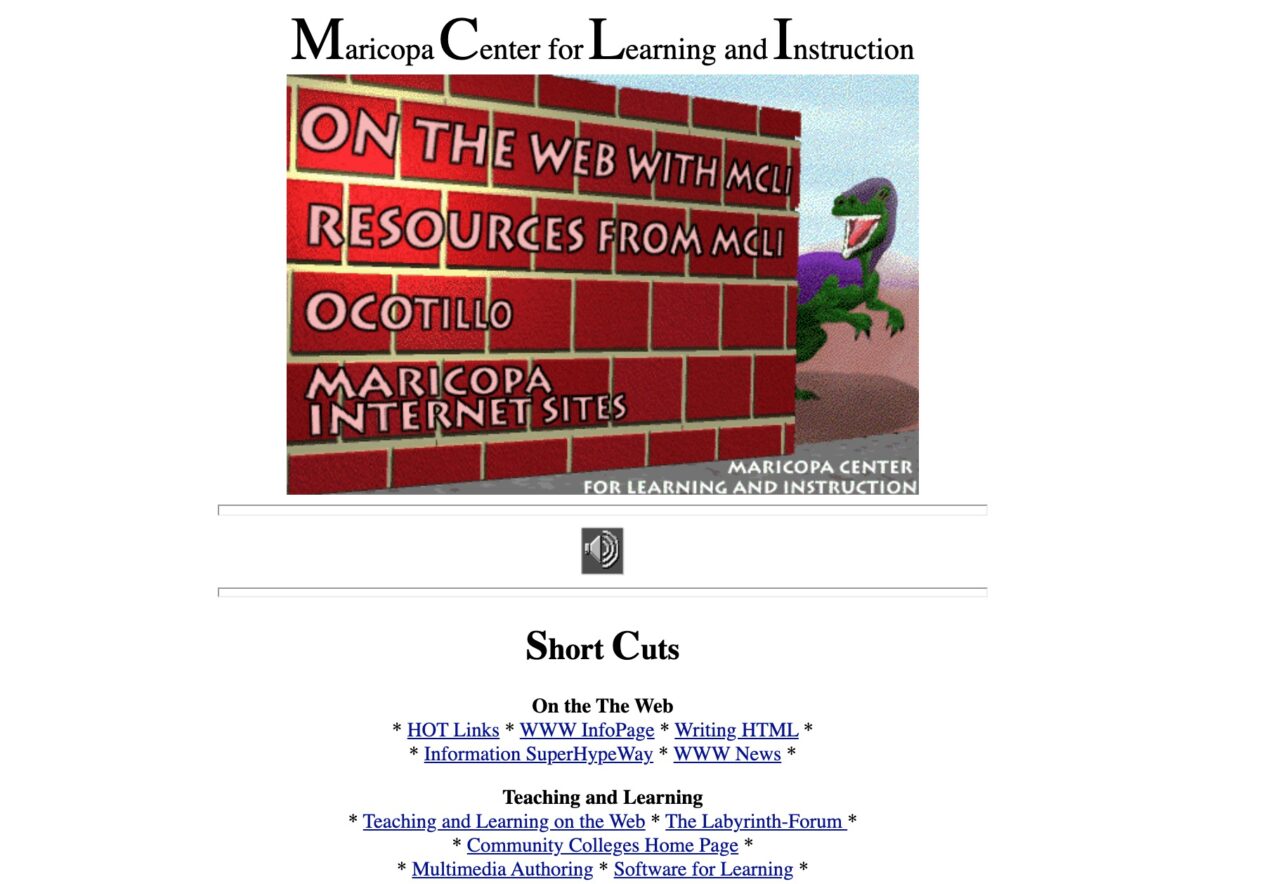



This, my friend, is an epic post.
The link is where it all begins, and the foundation upon which it all rests. Permissionless linking. Tim Berners-Lee understood this early on
Where I humbly (and presumptuously) differ from Sir Tim is that for me the link does mean something … but I agree it doesn’t mean what he says it doesn’t mean. The reference, though, is a meaning–or should be. “I have connected two things here” is one of the most meaningful things we do as human beings, and one of the things I routinely ask my students to do. I take Sir Tim’s point, however. (And I hope I got the html right, since there’s no way to edit the comment. :-))
Anyway, yes, a truly epic post (no Miltonist says that lightly, either!), and one I will re-read and return to many times. It’s an essential lesson in looking back so we can see more clearly how to move forward.
Thanks.
Triple checked it, but I busted the first link. Please repair. I will gladly pay you Tuesday for an html repair today.
Always glad to fix da link. Just need the proper destination.
Ah, I see your telepathy is down today. Typically you read minds very well! As the kids say, or used to say, hahaha. I believe what I missed was the close-quote at the end of the URL.
Here’s the link to the particular page. For good measure, a link to the entire site, full of TB-L goodness, including conceptual frameworks!
The mission statement is bracing and wonderful:
“Architectural and philosophical points
“These statements of architectural principle explain the thinking behind the specifications. These are personal notes by Tim Berners-Lee: they are not endorsed by W3C on anyone else. They are aimed at the technical community, to explain reasons, provide a framework to provide consistency for future developments, and avoid repetition of discussions once resolved.”
Ze link, it is feeeeexed.
For all my blog waxing about the power of knowing how to manually enter a link, here is the pitfall in the system. A missing quote and it all goes south. But then again, we have here banter… and even a J Wellington Wimpy visit.